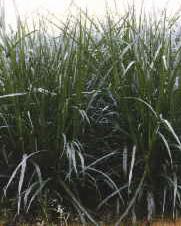

Common Name: Napier
grass, Uganda grass
Genus: Pennistum
Species: purpureum
Parts Used: leaves for animal fodder

Elephant grass is a tall grass that originally came from Africa in 1913. It grows in dense clumps of up to 10 feet tall. In the savannas of Africa it grows along lake beds and rivers where the soil is rich. Local farmers cut the grass for their animals, carrying it home in huge piles on their backs or on carts.
Yellowish or purple in color,the stems are coarse and hairy, and about 1 inch thick near the base. The leaves are 2 to 3 feet long, pointed at the ends, and about 1 inch wide. The edges of the leaves are razor-sharp. This makes stands of elephant grass nearly impenetrable. Many bird species make their home in the stands.
The dense seed heads of elephant grass are about 9 inch tufted plumes, usually a tawny or purple color. Elephant grass does reproduce sexually, but the seeds are very small and don't germinate well. The grass reproduces mainly through its rhizomes (root-like underground stems that produce roots below and sends up shoots to the surface).
Elephant grass can be very invasive and clogs the natural waterways of Florida which have to be cleared periodically. It likes tropical weather and can be killed by a light frost. The underground parts will stay alive if the soil doesn't freeze.
2000
Bibliography:
"Pennistum purpureum", http://www.hort.purdue.edu/newcrop/nexus/Pennisetum_purpureum_ nex.html, (Sept. 2000).
"Pennistum purpureum", http://www.hort.purdue.edu/newcrop/duke_energy/Pennisetum_ purpureum.html, (Sept. 2000).